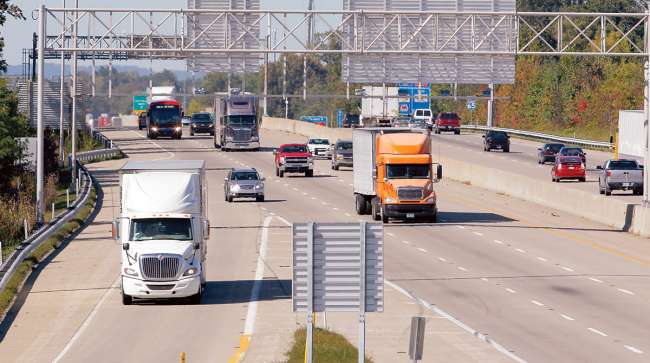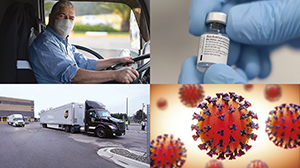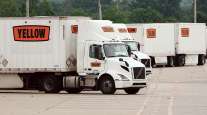Staff Reporter
Trucking Continues to Offer States Revenue Stability

[Ensure you have all the info you need in these unprecedented times. Subscribe now.]
One year since the COVID-19 pandemic caused vehicle travel and associated fuel tax revenue to plummet, recovery has been on a slow but positive trajectory.
Last spring, when stay-at-home orders prompted people to work from home and scrap vacation plans, states were hit with steep losses to funding streams tied to gasoline taxes.
However truckers, who stayed on the roads hauling essential supplies, continued to pump money into states’ accounts through diesel purchases.

A Year of Pandemic
Now, about a year after fuel sales reached dismal lows in April 2020, state departments of transportation indicate there’s a bit of improvement.
In Indiana, DOT spokesman Scott Manning indicated commercial truck traffic is slightly above pre-pandemic levels. According to INDOT, estimated truck vehicle miles traveled for 2020 was 31.4 million, Manning said, compared with 26.9 million in 2019. Meanwhile, passenger vehicle traffic is within 5%-8% of pre-pandemic levels (average daily vehicle miles traveled for passenger vehicles is approximately 204 million). At its lowest point last year, passenger vehicle traffic in Indiana tumbled to about 55%, Manning said.
The steady truck traffic levels recorded in Indiana reflected an active year for the freight transportation industry nationwide.
American Trucking Associations chief economist Bob Costello said though the industry had “pockets of weakness” in 2020, such as tank trucks that haul gasoline, freight activity in many sectors was strong. He added trucks were especially busy hauling groceries and home improvement goods.
“Overall, we’ve been buying,” Costello told Transport Topics. “We may change what we’re eating and where we’re eating, but we’re still eating. It has to do with consumption of retail goods, usually bought online, but it also is going to be related to better construction activity for home building as well as remodeling. That was strong last year.”
Trucking activity in Oregon in 2020 was also stronger than passenger vehicle travel. Oregon DOT chief economist Daniel Porter said motor fuel revenue in 2020 was down 5% to $589.2 million from 2019 levels, while weight-mile tax revenue was up 8.8% in 2020 to $409.5 million. These figures reflect a 5.9% fuel tax increase to 36 cents per gallon and a 5% weight-mile tax increase — both of which went into effect in 2020.
Oregon’s weight-mile tax applies to vehicles weighing more than 26,000 pounds and involved in commercial operations on public roads. Weight-mile tax rates increased uniformly across truck-weight classes in January 2020. Porter said the most common weight class is 80,000 pounds, and those trucks saw a 5% increase to 21.5 cents per mile from 20.48 cents per mile.
Although passenger vehicle traffic levels are slowly rebounding and truck traffic continues to offer some revenue stability, financial recovery will likely be long and challenging. According to the American Association of State Highway and Transportation Officials, a survey of states in January projects a revenue loss of $28 billion through fiscal year 2024.

Brouwer
Travis Brouwer, assistant director for revenue, finance and compliance at Oregon DOT, said fiscal 2020 and 2021 are expected to be down $225 million, with continuing reductions in future years.
Wyoming DOT lowered its fuel tax projections by about 18.5% to $95.5 million for 2021 to account for reduced traffic, said spokeswoman Aimee Inama. But so far this year collections are about $5.4 million ahead. Still, WYDOT is down about $2.3 million from its average collections between October and January of 2017-2020. Inama said in those periods WYDOT averaged about $42.6 million in fuel tax collections, and so far in fiscal 2021 the agency has received $40.3 million.
Pennsylvania DOT spokeswoman Alexis Campbell said gas tax revenue is down about $500 million since 2020. The agency currently has an $8.1 billion annual gap in highway and bridge funding needs. Pennsylvania relies on fuel tax revenue as some 74% of highway and bridge funding comes from state and federal gas taxes.
But with the pandemic ongoing, states are eyeing ways to shore up revenue.
To make possible @GovernorTomWolf's commitment to phase out the state's gas tax and to further address the state’s transportation funding needs, the Transportation Revenue Options Commission has been created. ➡ https://t.co/i3goeEurw4 pic.twitter.com/oINB605Gj5 — PA Department of Transportation (@PennDOTNews) March 12, 2021
PennDOT, for example, released in February a list of nine interstate bridge projects being considered for tolling — which the state’s trucking community has bristled against. And on March 12, Gov. Tom Wolf established the Transportation Revenue Options Commission to develop funding recommendations with a goal of phasing out the gas tax. Pennsylvania taxes 75.2 cents per gallon for diesel and 58.7 cents per gallon for gasoline.
Likewise, in Maine a $105 million transportation bond measure was approved in July by a margin of 78%.
New Jersey offset declines in fuel consumption in October by raising the gas tax 9.3 cents per gallon, bringing its total tax rates to 57.7 cents per gallon for diesel and 50.7 cents per gallon for gasoline.
Manning said Indiana DOT representatives have been following discussions at the federal level regarding an infrastructure investment package and state and local financial aid.
Transportation Secretary Pete Buttigieg in February suggested the merits of a usage charge system — so long as privacy concerns could be addressed.
But Richard Auxier, senior policy associate at the Tax Policy Center, said a road usage charge would not be a viable funding solution.
“The thing with the gasoline tax is it’s not that people have an objection to the system of taxation, they just don’t want to pay more,” Auxier told TT. “If you change the tax and you raise the tax that way, they’re going to figure that out. If the question is how do we think about our long-term infrastructure, [the usage charge] is a good answer. If the question is how do we get infrastructure built now and get over financing problems now, it can only be seen as a small nudge and not an actual answer to that immediate problem.”
It’s still too early to determine whether passenger vehicle traffic will climb to pre-pandemic levels considering teleworking practices may remain when the pandemic ends, said Chris Sullivan, product domain manager at TomTom, which specializes in location technology and produces maps and traffic information.
“For the most part, we’re not seeing the same congestion still,” Sullivan told TT. “I don’t know if we will or not in the consumer space. I still think there’s been a huge shift to remote work. I would expect this trend to continue for a little while. We may not get back to 2019 congestion levels.”
Indeed, many of the nation’s employers have already extended working from home. Ford Motor Co., one of the largest among them, is allowing more than 30,000 to use the office only when they need to once the pandemic is ended.
Such decisions will sap passenger traffic levels — and the gas tax revenue tied to them — but truck traffic will stay strong, spelling good news for states’ diesel tax revenue.
“I think this year is not only going to be a good year for the general economy, but it’s going to continue to be a good year for trucking,” Costello said.
Want more news? Listen to today's daily briefing below or go here for more info:




